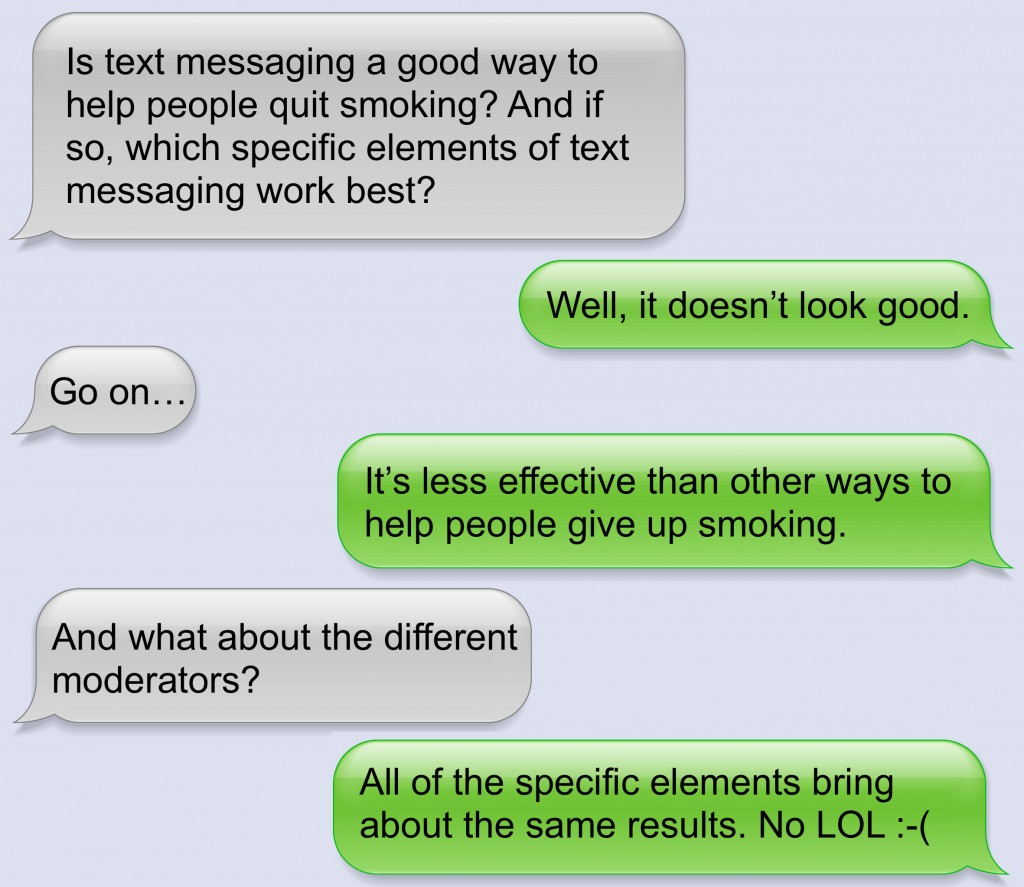by Olivia Maynard @OliviaMaynard17
This blog originally appeared on the Mental Elf site on 26th August 2015.
The efficacy of different smoking cessation interventions is always a hot topic around our woodland campfire. We’ve blogged previously about the effectiveness of both pharmacological and psychological treatments for smoking cessation, as well as their effectiveness among different populations of smokers.
A recent systematic review and meta-analysis investigated the efficacy of SMS text message interventions for smoking cessation. Unlike the majority of other smoking cessation interventions, using mobile phones to deliver health information allows for direct interaction between clients and practitioners without face-to-face interaction and permits the collection of large amounts of data. It is therefore cost-effective and easily scalable to large populations.
Previous meta-analyses have looked at the effectiveness of text messaging interventions for smoking cessation, but the review recently published by Spohr and colleagues is the first to investigate which elements or moderators of text message interventions are the most effective in supporting smoking cessation.

Methods
The authors searched for randomised controlled trials which investigated the efficacy of text messaging interventions for smoking cessation. Only studies which included a follow-up measure of smoking abstinence were included. 13 articles met all of these inclusion criteria.
The authors also extracted information on the use of each of the moderators described below:
- Intervention type:
- SMS only;
- ‘SMS plus’ (where SMS support is combined with either face-to-face or web-based support).
- Message frequency:
- Fixed message schedule (a consistent number of messages throughout the intervention);
- Decreasing schedule (most messages at quit attempts, followed by a gradual reduction);
- Dynamic schedule (depends on the stage of cessation the client is at).
- Message track:
- Fixed message track (users cannot influence the course of the intervention);
- Dynamic message track (user quit status and stage of change can influence intervention messages).
- Message tailoring:
- Tailored messages (customised message content to a specific individual);
- Targeted messages (customised messages to a population subgroup).
- On-demand messaging:
- On-demand messaging (allow users to text a keyword in emergency situations to receive additional support. Some interventions allow users to connect with other users for support and encouragement).
- Message direction:
- Unidirectional messaging (by the researcher);
- Bidirectional messaging (to obtain data from the client).
- Message interaction:
- Researcher-initiated (containing intervention messages and assessment questions);
- User-initiated (containing requests for additional support).
Intervention success was assessed using seven-day point prevalence as the primary outcome measure, as 11/13 of the studies reported these results. Two other studies only reported 6 month continuous abstinence.
The researchers used an intention to treat analysis.

Results
The 13 articles resulted in a cumulative sample size of n = 13,626. Participants were primarily adult smokers (six studies), but four studies recruited participants aged 15 or over and three targeted adolescents and young adults (ages 16-25).
Smoking quit rates for the text messaging intervention groups were 35% higher as compared to control groups (OR = 1.35, 95% CI = 1.23 to 1.49).
Overall, the analysis of the intervention moderators did not find strong evidence that any particular moderator was more effective than any other:
- Intervention type:
- There were no differences (QB = 0.56, df = 1, p = 0.46) in intervention efficacy between those which provided text-only support (k = 6) as compared with text messaging plus additional support (k = 7).
- However, text-only interventions had a slightly larger effect size than those with text messaging plus additional support.
- There were no differences (QB = 0.89, df = 1, p = 0.35) in intervention efficacy between those which promoted the use of nicotine replacement therapy (NRT) (k = 7) as compared with those which did not (k = 6).
- Message frequency:
- There were no differences (QB = 0.96, df = 2, p = 0.62) in intervention efficacy between those which provided decreasing schedule (k = 8) as compared with fixed schedule (k = 3) or variable schedule (k = 2) support.
- However, those which had a fixed schedule had larger effect sizes than either of the other types of schedules.
- Message track:
- There were no differences (QB = 0.38, df = 1, p = 0.54) in intervention efficacy between those which used a fixed message track (k = 5) as compared with a dynamic message track (k = 8).
- Message tailoring:
- There were no differences (QB = 1.54, df = 2 p = 0.46) in intervention efficacy between those which used message tailoring (k = 8) as compared message targeting (k = 1) or a combination of both (k = 4).
- All studies included some form of message content tailoring.
- On-demand messaging:
- There were no differences (QB = 0.15, df = 1, p = 0.70) in intervention efficacy between those which used on-demand messaging (k = 11) as compared with those which did not (k = 2).
- There were no differences (QB = 0.02, df = 1, p = 0.88) in intervention efficacy between those which provided peer-to-peer support (k = 5) as compared with those which did not (k = 8).
- Message direction:
- All of the studies used bidirectional messaging so the effectiveness of this moderator to unidirectional messaging could not be assessed.
- Message interaction:
- There were no differences (QB = 0.17, df = 1, p = 0.68) in intervention efficacy between those which included assessment messages (k = 7) as compared with those which did not (k = 6).

Conclusions
This meta-analysis found that smoking cessation interventions which used text-messaging increased the odds of successfully quitting smoking by 35%.
To put this in perspective, other reviews have found that telephone quit lines increase smoking cessation success by 60%, social support increases success by 30% and practical counselling by 50%. NRT and other medications have been shown to increase cessation success by between 50% and 310% (Fiore et al., 2000).
None of the moderators investigated here were found to be more effective than any other. There was some evidence that interventions which used fixed schedules were more effective than those which used either decreasing or variable schedules. Similarly, there was some evidence that text-only support programs were more effective than those which provided a ‘text-plus’ service. However, there was no robust statistical evidence for these differences.
Overall, these results provide no evidence that text-messaging interventions, which are more complex and time-demanding (i.e. text-plus, on-demand messaging, variable schedules, social support communication), are any more effective than the simplest interventions.
However, given the cost-effectiveness, relative ease of delivery and promise of efficacy of these interventions, future research should continue to determine what moderators make an effective text-based intervention.
Limitations and future directions
These results should be treated with caution however, for a number of reasons:
- The authors relied on data obtained from the original articles to compile this meta-analysis, rather than contacting the researchers themselves. As data regarding the actual use by users of some of the moderators such as social support and on-demand messaging was not reported in articles, we cannot be certain whether the failure of these moderators to increase quit success is because they are simply not more effective, or because users didn’t actually use these services.
- The number of studies included in this meta-analysis was small (only 13 studies). This is even more the case for the moderator analyses. Drawing firm conclusions from the statistical evidence is therefore difficult.

Links
Primary paper
Spohr SA, Nandy R, Gandhiraj D, Vemulapalli A, Anne S, Walters ST. (2015) Efficacy of SMS Text Message Interventions for Smoking Cessation: A Meta-Analysis. Journal of Substance Abuse Treatment, 56, 1-10. doi: http://dx.doi.org/10.1016/j.jsat.2015.01.011
Other references
Fiore MC, Bailey WC, Cohen SJ, Dorfman SF, Goldstein MG, Gritz ER, … Lando HA. (2000) Treating tobacco use and dependence: a clinical practice guideline: Publications Clearinghouse.
– See more at: http://www.nationalelfservice.net/mental-health/substance-misuse/sms-texting-to-quit-smoking-a-meta-analysis-of-text-messaging-interventions-for-smoking-cessation/#sthash.hjMwMixu.dpuf
